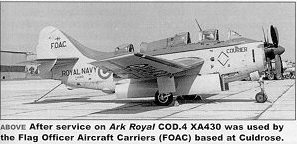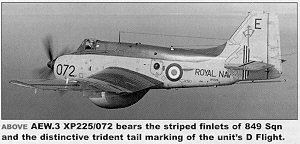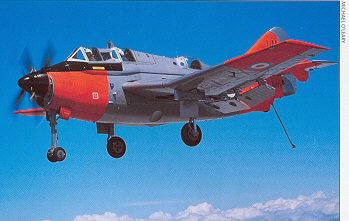Fleet Air Arm Gannet squadrons
 700
Squadron
� Re-formed at
Ford on August 18, 1955, from 703 and
771 Sqns as the Trials and Requirement Unit for the Gannet AS.1. This
unit assessed the suitability of new aircraft types for Fleet Air
Arm (FAA) use. Gannet AS.4s arrived in February 1957. Ford closed as
part of the Defence cuts in 1958, 700 Squadron moving to Yeovilton on
September 19, 1958. Gannet T.2s arrived in March 1959. When 700 Squadron
was disbanded on July 3, 1961, any
Gannets on strength went to 771 Squadron, a Fleet Requirements Unit 700
Squadron
� Re-formed at
Ford on August 18, 1955, from 703 and
771 Sqns as the Trials and Requirement Unit for the Gannet AS.1. This
unit assessed the suitability of new aircraft types for Fleet Air
Arm (FAA) use. Gannet AS.4s arrived in February 1957. Ford closed as
part of the Defence cuts in 1958, 700 Squadron moving to Yeovilton on
September 19, 1958. Gannet T.2s arrived in March 1959. When 700 Squadron
was disbanded on July 3, 1961, any
Gannets on strength went to 771 Squadron, a Fleet Requirements Unit
700G Flight
� Intensive Trials Unit which assessed the Gannet AEW.3
for service use at Ford between August 1959 and January 1960
703X Flight � Intensive Trials Unit of 703 Squadron which formed on
March 15, 1954, at Ford to assess the Gannet AS.1. This included
tropical trials and operating from a carrier deck. The trials ended on
December 21, 1954, with the Gannets passing to 700 Squadron
719
Squadron � Operated with 737 Squadron as a Naval Air Anti-Submarine
School at Eglinton, Northern Ireland. On November 22,
1957, 719
absorbed 737 with a name change to Naval Anti-Submarine
Operational Flying School. Gannet
AS.1s and T.2s arrived in November 1955 and stayed in use until
March 1959
737 Squadron
� As part of the joint training unit with 719 Squadron
the unit
received Gannet AS. 1s and T.2s in March 1955 and operated
them until the change of role in
November 1957
744 Squadron � Re-formed at Culdrose on March 1, 1954, as
a Naval Air-Sea War Development Unit operating Firefly AS.6s. The unit
moved to St Mawgan on October 23, 1954, and received its first Gannet
AS. 1s in May 1955, joined by Avenger
AS.5s in July of that year. In October 1955 the units name was changed
to reflect its new role
� Naval Anti-Submarine Development Squadron. The squadron disbanded on
October
31, 1956
796
Squadron
� From early
1956 this squadron became the Observer
and Air Signals School operating
Fireflies. A Gannet T2 arrived in
February 1957 for crew training,
followed in April by Gannet AS. 1s. After
converting to Skyraiders the squadron
disbanded on October 1,1958
810 Squadron
� On April 20, 1959, 810 Sqn reformed at Culdrose with six Gannet AS.4s
and after working up moved to Gibraltar in June
in preparation
to join HMS Centaur. A cruise through the Mediterranean was
followed by a trip to the Far East and on to Australia. They returned
in April 1960 to Culdrose but
re-embarked for a visit to Stockholm. The squadron was disbanded aboard
Centaur on July 12, 1960, after which the Gannets flew ashore to
Culdrose
812 Squadron
� Reformed on November 7,1955, at Eglinton as an
anti-submarine
squadron. It received eight Gannet AS.1s and a T.2
before embarking in HMS Eagle for a Mediterranean work-up in April
1956. On August 3, 1956, the Gannets flew ashore to Hal Far,
Malta, on standby for action during
the Suez Crisis. They flew to Lee-on-Solent where the squadron was
disbanded on December 13, 1956
814
Squadron
�
This unit received eight Gannet AS.4s and one T.2 at Culdrose on January
14, 1957. The squadron embarked in HMS Eagle
in August 1957 and took part in
Exercise Strike Back in Norwegian waters. HMS Eagle moved
to the Mediterranean where the squadron spent time between the
ship and Hal Far, Malta. Early in 1959 they took
part in another exercise and after a
visit to Brest flew ashore to Culdrose where the squadron disbanded on
September 30, 1959
815
Squadron
� Reformed with eight Gannet AS.1s and a T.2 at Eglinton on February 6,
1956. Embarked in HMS Ark Royal in January
1957 and spent three weeks in American waters during May. During this
period
FAA squadrons cross-operated with aircraft from the American carrier
USS Saratoga. In December 1957 the Gannet AS. 1s were
exchanged for AS.4s and time was
spent with Ark Royal in the Mediterranean before returning
to Culdrose to disband on July 15,1958
820 Squadron
� Received nine Gannet AS. 1s at Eglinton on March 7,
1955. Embarked
in HMS Centaur during January 1956 for operations in
the Mediterranean and Far East, after
which the squadron relinquished its Gannet AS. 1s into storage at
Donibristle. Formed up at Eglinton on July 30, 1956, with eight Gannet
AS. 1s. Embarked in HMS Bulwark in
June 1957 but was disbanded on
December 2, 1957
824
Squadron
� Equipped with eight Gannet AS.1s in February 1955 followed by a T.2 in
April. After a short spell in HMS Bulwark the
squadron
embarked in HMS Ark Royal during October 1955 for Exercise
Dawn Breeze.
The squadron disbanded at Ford on
April 17, 1956, only to re-form at Culdrose the following month,
still with Gannet AS. 1s. In October
these were replaced by nine Gannet AS.4s and the following January
joined Ark Royal. A move to HMS Albion followed before
being disbanded at Culdrose on November 1, 1957
825
Squadron
� Re-formed on July 4, 1955, at Culdrose with eight
Gannet AS.1s, receiving a T.2 in October. In January 1956 the squadron
embarked in HMS Albion and visited the Far East before returning
to Lee-on-Solent to disband on August 7,1956. On May 6, 1957, the
squadron re-formed at Culdrose with nine Gannet AS.4s and flew to Hal
Far, Malta, in January 1958. The squadron relinquished its Gannets on
April 29, 1958, when it disbanded at
Culdrose
826
Squadron
�
Received eight Gannet AS. 1s on January 17, 1955. Joined HMS Eagle
in June 1955 for a trials period in the Mediterranean.
Later that year took part in Exercise
Sea Enterprise operating in Scandinavian waters and off the Faroe
Islands. Happy with the results
showing the Gannet to be an effective anti-submarine aircraft, the
squadron returned to Lee-on-Solent to disband on November 22, 1955
831 Squadron
� An Airborne Electronics Warfare squadron formed by renumbering 751
Squadron at Culdrose on May 1, 1958. Although
operating various types of aircraft two Gannet AS. 1s were received for
A
Flight, joined in February 1959 by a Gannet ECM.4. For efficiency in
training with the Fleet during 1959-60, 831 Sqn was awarded the
prestigious
Boyd Trophy. In July 1963 the squadron moved to RAF Watton, Norfolk, for
better liaison between the two services on electronic
warfare. The unit was disbanded on
August 26, 1966; the Electronic
Countermeasures (ECM) role was handed over to 360 Sqn
847 Squadron
�
Formed up from 812 Squadron on March 17, 1956, at Eglinton. Three Gannet
AS. 1s were based at Nicosia, Cyprus, to provide daily patrols to curb
arms smuggling. The AS. 1s were replaced
by three Gannet AS.4s in June 1958
and continued until November 1959. The unit then disbanded at
Yeovilton on December 1, 1959
849
Squadron
� This unit was unique in that it consisted of a Headquarters Flight
which was permanently shore-based, and four
Flights, any
one of which could be supplied to a carrier when going on a commission.
Each Flight was normally made up of four Gannet AEW.3s
and one Gannet COD.4 to provide
ship-to-shore communications. When
not required the Flights were
shore-based with the HQ Flight
1840/1842 Sqns
� Gannets joined 1840 Sqn of the Royal Naval
Voluntary
Reserve (RNVR) in February 1956 when 11 Gannet AS. 1s
and a T2 replaced the unit's
Fireflies. Sharing the aircraft as part of the Channel Air
Division was 1842 Squadron, both being based at Ford. In
the Defence Review cuts of 1957 all
RNVR squadrons were disbanded on March 10, 1957
Ship's Flights
� Carriers Ark Royal, Eagle, Hermes and Victorious all
operated Gannet COD.4s at various times between November 1961 and
December 1969
Station Flights
� Abbotsinch
Gannet T2 Sep 1958-1962
Gannet T.5 Sep 1958-May 1959
Anthorn
Gannet
T.2 May 1956-Sep 1957
Culdrose
Gannet T.5 Apr 1959-Sep
1966
Eglinton
Gannet T.2 Jul 1957-Nove 1958
Ford
Gannet T.2 Nov 1956-Feb 1958
Yeovilton
Gannet T2
May 1959-Jun 1959
Gannet AS.4
Feb 1961-May 1962
The Royal
Radar Establishment (RRE) at Defford used a Gannet AS.1
in 1956 for tests on the Blue Silk
Doppler navigation radar system
RRE Pershore used two Gannet AEW.3s during 1969-72 for AN/APS-20
radar development

 |
![]()






